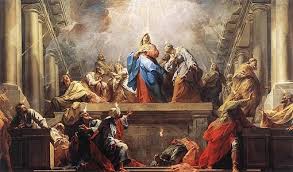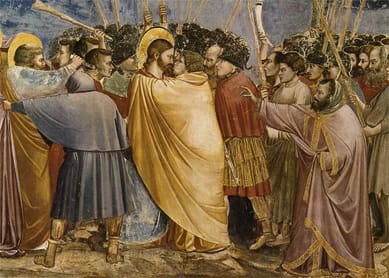There are certain terms within the Christian lexicon that are so familiar that we can, like St. Augustine’s own struggle with time, define them as long as no one asks. Faith is just one such term. It serves as a catch-all term that encompasses in generality belief and trust, although often in such an ambiguous manner that we strain to see what it is clearly. Yet it remains a most important term, one by which, Sacred Scripture tells us, we are saved. Therefore it behooves us to spend some time reflecting on faith.
We must admit at the outset that some of the ambiguity surrounding faith stems from a failure to distinguish between natural and supernatural powers. Faith is both a natural and a supernatural act. Put more accurately, there are two types of faith—natural and supernatural. All men have natural faith, but not all men receive supernatural faith. This distinction is often lost when countering atheists who insist that faith is unreasonable. What they mean is that supernatural faith is unreasonable, while the Christian apologist insists that even the atheist has faith although what he means is natural faith. The two end up missing each other entirely because they are on two different planes of argument. Unfortunately, this distinction often becomes muddled in our mind and not just in our apologetics.
Faith means an assent given to a particular proposition based not on direct evidence, but on the credibility of the witness. One accepts the proposition as true because they believe the one who tells them. As St. Thomas puts it, faith is the assent to those things which are unseen (ST II-II, q.4, a.1). So, faith has two aspects, the “thing unseen” and the assent. It is both knowledge and consent, requiring both intellect and will with an emphasis on the latter. Faith, then, only pertains to those things we do not see—for to see brings certainty and requires no assent on our part. Faith becomes a source of knowledge of many, many things, and thus we can see how it is indispensable for man to grow in knowledge of anything.
We can further our understanding if we grasp the difference between faith and opinion. Because it rests upon the credibility of the witness always carries with it subjective certainty. Opinion on the other hand is always accompanied by a fear or doubt that one is in error leading to some degree of reservation of full assent. Doubt can move to certainty either by fully assenting to the trustworthiness of the witness or by gathering more evidence.
Natural vs Supernatural Faith
The distinction between natural and supernatural faith then rests in who the witness is. For natural faith, the witness is another man. For supernatural faith, the witness is God Himself. Blessed John Henry Newman defines faith as ““assenting to a doctrine as true, which we do not see, which we cannot prove, because God says it is true, who cannot lie.” In short, faith is an act of trust in the authority of God as revealed. What He has said becomes, in a certain sense, secondary, to the fact that He has said it. Whatever He says we deem as true because He has said it. It is in this way that faith becomes synonymous with trust. Their “reasonableness” then takes a back seat and faith “comes from hearing” (Romans 10:17) the Word of God as such.
One does not “graduate” from natural faith to supernatural faith. “Our vision of the face of God,” St. John Paul II says, “is always impaired by the limits of our understanding. Faith alone makes it possible to penetrate the mystery in a way that allows us to understand it coherently” (Fides et Ratio, 13). Because it is part of the human condition, especially in its fallen state, to abhor a mystery, we naturally shun divine faith. Therefore, it must be bestowed upon us from above. Supernatural faith is a gift and not something that we can achieve on our own. It can grow through our actions once it is implanted, but it is never something we can achieve. We can make no judgment upon it, we can only submit. It is the giving of our minds to God so that He might fill them with knowledge of Himself.
To this point we have been overlooking an important aspect: if faith consists in assent to God’s Word, how do we recognize His voice? The problem as Newman further explains is that “God says it is true, not with His own voice, but by the voice of His messengers, it is assenting to what man says, not simply viewed as a man, but to what he is commissioned to declare, as a messenger, prophet, or ambassador from God” (Faith and Private Judgment). This is where the previously mentioned motives of credibility come in. Many men purport to speak for God, but in only one place do we find good reasons to believe in the reliability of His witnesses—the Catholic Church. Whether it be the prophecy, the miraculous endurance of the Church, or the manner in which it spread, there are reasons to believe that the fullness of Revelation subsists in the Catholic Church. By having human faith in the Apostles and their successors, it prepares the way for the gift of divine faith given to us in Baptism.

This is exactly what we see during the Peter’s homily on Pentecost. He provides them with the motives of credibility—the miraculous pouring of the Holy Spirit and an explanation of the prophets so that once they believed him as the messenger, they ask “what are we to do, my brothers?” Peter tells them to be baptized so that they will receive the gift of divine faith. Natural faith prepared their hearts for the gift of divine faith.
Practical Consequences
There are two further implications of this, both of which Newman addresses. First, Catholics are often accused by Protestants of pinning their faith in the Pope or a Council. But this is exactly what the first Christians did by submitting themselves to the Apostles. It was reasonable for them to believe that what the Apostles preached was true and through the gift of divine faith they were given certainty that what they preached came from God. It was their natural faith that gave them the proper disposition to receive the supernatural gift of faith. They believed that God had revealed it and thus many of them were willing to witness to that truth through the gift of their martyrdom.
Secondly, those who subscribe to “Cafeteria Catholicism” do not have supernatural faith. Recall that saving faith means an assent of the mind to God’s revelation. To pick and choose what you will believe is not supernatural faith, but a form a private judgment. It is only accidental that what you believe coincides with what God has truly revealed. This is, at best, natural faith, although one would stain to defend it as faith at all since it rests neither on human or divine authority but on opinion. This is also why the Church does not allow her children to entertain any doubts because a Catholic is only a Catholic while he has faith. Faith is incompatible with doubt so that Newman says, “No one can be a Catholic without a simple faith, that what the Church declares in God’s Name is God’s Word, and therefore, true.”

















